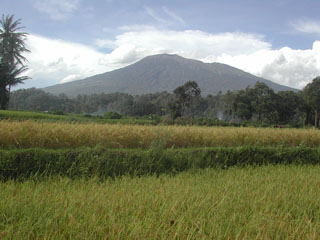Report on Marapi (Indonesia) — 27 November-3 December 2024
Smithsonian Institution / US Geological Survey
Weekly Volcanic Activity Report, 27 November-3 December 2024
Managing Editor: Sally Sennert.
Please cite this report as:
Global Volcanism Program, 2024. Report on Marapi (Indonesia) (Sennert, S, ed.). Weekly Volcanic Activity Report, 27 November-3 December 2024. Smithsonian Institution and US Geological Survey.
Marapi
Indonesia
0.38°S, 100.474°E; summit elev. 2885 m
All times are local (unless otherwise noted)
The Pusat Vulkanologi dan Mitigasi Bencana Geologi (PVMBG, also known as CVGHM) reported declining activity at Marapi. During 23-30 November white plumes rose 100-150 m above the summit. Two eruptive events were recorded by the seismic network on 29 November, but weather clouds prevented visual observations; any ejecta likely fell near the crater. Earthquake signals indicating eruption events were rarely being recorded and signals indicating emissions were declining. The number of deep volcanic earthquakes was lower compared to the previous week and other seismic indicators showed stability. RSAM values fluctuated around baseline levels. No deformation during 15-27 November was detected using InSAR or data from the Batupalano Station tiltmeter. Sulfur dioxide emissions measured from satellite were low at 57 tons per day on 24 November. In general monitoring data and activity levels fluctuated but declined overall. The Alert Level was lowered to 2 (on a scale of 1-4) at 1500 on 1 December, and the public was warned to stay 3 km away from the active crater.
Geological Summary. Gunung Marapi, not to be confused with the better-known Merapi volcano on Java, is Sumatra's most active volcano. This massive complex stratovolcano rises 2,000 m above the Bukittinggi Plain in the Padang Highlands. A broad summit contains multiple partially overlapping summit craters constructed within the small 1.4-km-wide Bancah caldera. The summit craters are located along an ENE-WSW line, with volcanism migrating to the west. More than 50 eruptions, typically consisting of small-to-moderate explosive activity, have been recorded since the end of the 18th century; no lava flows outside the summit craters have been reported in historical time.
Source: Pusat Vulkanologi dan Mitigasi Bencana Geologi (PVMBG, also known as CVGHM)

